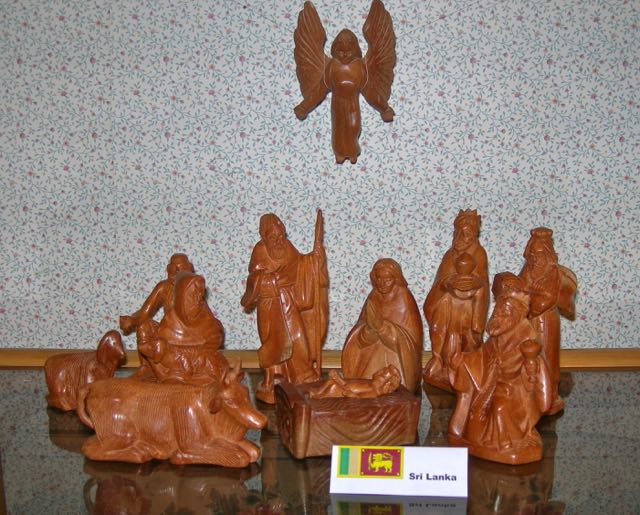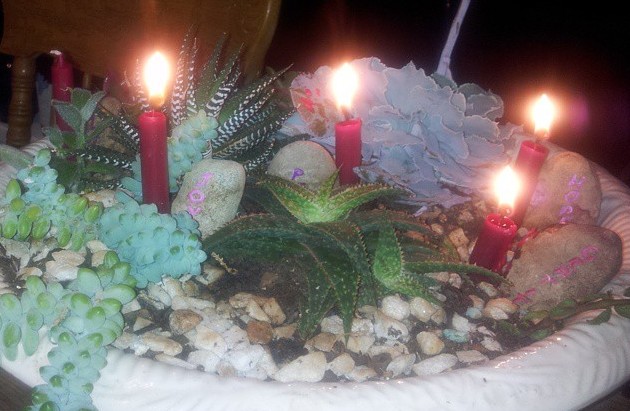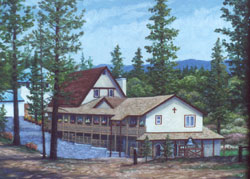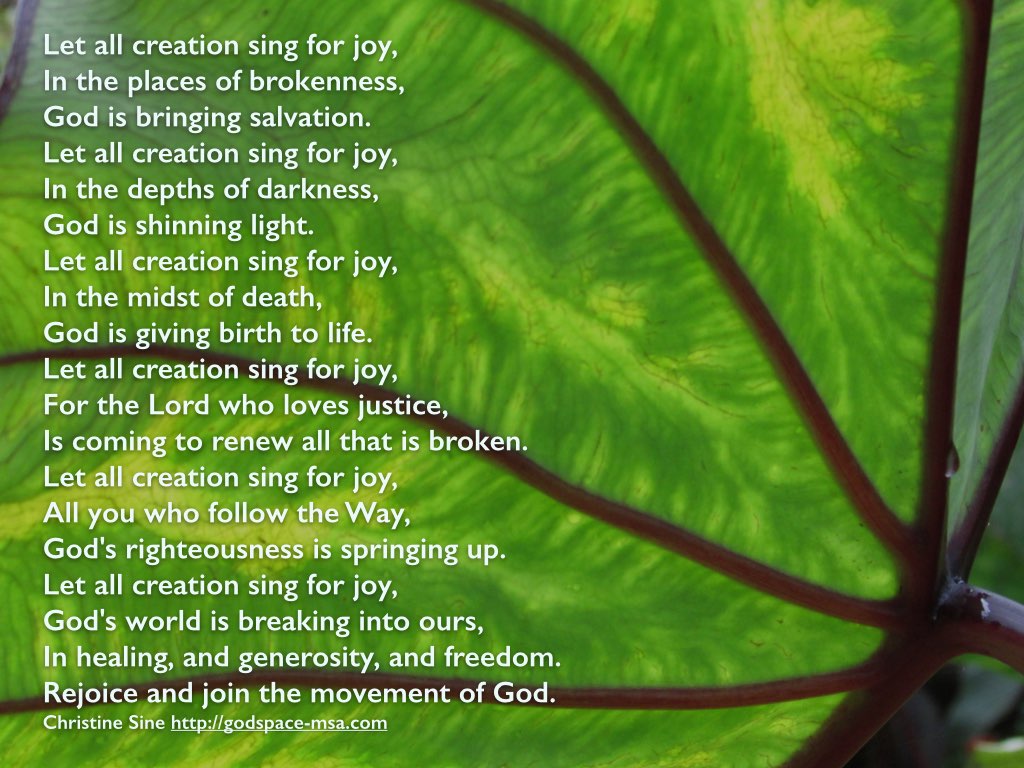
And in the same region there were shepherds out in the field, keeping watch over their flock by night. And an angel of the Lord appeared to them, and the glory of the Lord shone around them, and they were filled with fear. Luke 2:8-9
Imagine your feelings as a shepherd, mechanically carrying out your night watch—probably a little cold, a little bored, listening to the snuffling and bleating of the sheep, trying to stay alert for any indications of impending danger, but not really expecting so much as a fox to scuttle past the flock. Then suddenly the darkness and stillness of the night is shattered by the glorious appearance of an angel of the Lord—an event no more anticipated in the shepherd’s daydreams than in ours. No wonder, as the King James Version puts it, “they were sore afraid.”
In most of our nativity sets, the shepherds lean placidly on their staffs gazing serenely at the infant Jesus. I like the posture of the shepherd in this Sri Lankan set, as he doffs his hat (yes, he has a hat!) and kneels in reverence beneath the descending angel. He responds in submission to the sudden glory that has overtaken him and his companions as they carried out their ordinary and lowly tasks.
In our modern world we tend to sanitize and glorify the occupation of a shepherd, picturing a gentle man clothed in pristine white robes, holding an equally immaculate and placid lamb. No dirt and no odor. The lamb does not squirm or struggle. Yet shepherds in first century Palestine were a despised class, not yet elevated to our romanticized version. They lived outside with the sheep, and most likely did not bother with the niceties of bathing and tooth brushing. And shepherds, in spite of the responsibility their profession required, were often regarded as disreputable and dishonest.
Yet God chose to honor those of low esteem in human terms by entrusting the shepherds with the first announcement of His Son’s birth. The angel did not appear to the priests in the temple, but to the shepherds in the fields. God seems blissfully oblivious to our human prejudices and social structures. As Paul reminds the Corinthians:
For consider your calling, brothers: not many of you were wise according to worldly standards, not many were powerful, not many were of noble birth. But God chose what is foolish in the world to shame the wise; God chose what is weak in the world to shame the strong. God chose what is low and despised in the world . . . so that no human being might boast in the presence of God. (I Corinthians 1: 26-29)
If you are one God has blessed with the gift of belief in His Son, count yourself in the company of the shepherds, chosen not because of your status or competence or goodness, but simply gifted with grace.
Jean Andrianoff and her husband David spent 25 years in Asia where they began collecting the nativity sets that inspired this selection. They now live on the Olympic Peninsula in Washington State, where Jean finds inspiration for writing from God’s creation, family, life experiences and her faith in Jesus. She blogs with a group of like-minded friends at www.wordways.org and is the author of Chosen for a Special Joy.

Yesterday I lit the joy candle in my Advent garden an exhilarating moment that marks the halfway point in our journey toward the coming of Jesus. The scriptures we read at church were all about joy and rejoicing. I will greatly rejoice in the LORD, my whole being will exult in my God, we read in Isaiah 61; Rejoice always says Paul in 1 Thessalonians 5:16; Those who sowed with tears will reap with songs of joy; sings the psalmist in Psalm 126.
What is this joy toward which the season now beckons us? Sometimes I think we confuse joy and rejoicing with happiness. Joy is not a warm fuzzy feel good sensation. It is a rejoicing in the fact that all that was broken by sin, all that is used to oppose God and lifted up against God has been judged. But God’s fearsome judgement which shakes the earth in order to root out evil, is not a judgement of destruction but of redemption and transformation.
In his important new book A New Heaven and A New Earth; Reclaiming Biblical Eschatology, Richard Middleton tells us:
Judgement for the sake of redemption is the consistent pattern of Scripture. Thus the scattering of Babel and confusion of languages allowed a fresh beginning for humanity, without imperial oppression. At the flood, the violence of the world was subjected to radical cleansing so that Noah and his family could start over. The Babylonian exile, likewise, served to dismantle Israel’s idolatry and injustice in order to permit a new beginning for God’s people, on different footing. The biblical patter is that God smites and heals. (125)
He goes on to say:
God’s ultimate purpose is to accomplish his original intent for the flourishing of humanity (Israel and the nations) and the nonhuman world. (126)
In the life, death and resurrection of Christ, this ultimate purpose of God, the flourishing of God’s creation is accomplished
Originally Advent did not celebrate the birth of Christ but rather the birth of God’s new world in which death and sin are no more. The entire creation rejoices because through God’s judgement, it is liberated from the burden of human sin and evil. Listen to how the psalmist expresses this in Psalm 96:11-13 NLT
Let the heavens be glad, and the earth rejoice!
Let the sea and everything in it shout his praise!
12 Let the fields and their crops burst out with joy!
Let the trees of the forest sing for joy
13 before the Lord, for he is coming!
He is coming to judge the earth.
He will judge the world with justice,
and the nations with his truth.
All humanity are invited to rejoice with creation as we participate in this transformation. As we stand around the manger together we are invited to break down barriers that oppress and imprison. We are invited to give our lives to heal those who suffer, to feed those who hunger and to share with those who lack provision.
That is indeed cause for joy and rejoicing.
So as you walk through this third week of Advent what will you do that will bring rejoicing and flourishing to God’s world?
This is the third podcast which we recorded last year. Enjoy
 Story by Mary September
Story by Mary September- Music by Tracy Howe Wispelwey, In Mansions and Church of the Beloved
- Reflection by Rev. Karen Ward, All Souls Episcopal Church, Portland, OR
- Meditation by Christine Sine, Mustard Seed Associates
- Produced by Ryan Marsh, Church of the Beloved, Edmonds WA
Listen to Mary September reflect on the pain of separation from her family and home. Join Karen Ward in her reflections on Advent and Tracy Howe Wispelwey’s beautiful song. The closing meditation comes from Waiting for the Light: An Advent Devotional.
Or right click this link and save to your computer Advent Podcast Week Three
Join us each day this week as we continue to reflect on the theme Coming Home
Ponder with us: Where would you like to see Christ born in your neighbourhood and in your life this week?
This is the third of four Advent podcasts produced by Ryan Marsh of Church of the Beloved for the Godspace blog.
If you missed the first podcast you can listen to it here and you can find the second podcast here
If you are just tuning in on this you may also like to watch the Advent meditation videos:
Alleluiah the Christ Child Comes
The Coming of the Lord is Near
And don’t forget our other Mustard Seed resources including these beautiful prayer cards that we have put together. Your purchase of these resources is one way to help support the Godspace blog and the ministry of Mustard Seed Associates.
We hope that you will join us next week and the following for our fourth and last podcast.
Week Four of Coming Home
- Story by Mustard Seed House
- Music by Lacey Brown, In Mansions and Church of the Beloved
- Reflection by Tom Sine, Mustard Seed Associates
- Meditation by Christine Sine, Mustard Seed Associates
- Produced by Ryan Marsh, Church of the Beloved
Yesterday I was sent this link to an article about stores that benefit non-profits. My first thought was – not many Christian organizations there. Then I started thinking about the many I know that do benefit non-profits and realized it was time for another Christmas list. For those of us that love Christmas, buying to support our favourite organizations is one way to go. I am not going to list the many wonderful organizations that run thrift stores or provide gift catalogues for you to buy goats, bees, land or other items to help people in impoverished communities. That would make another whole list. These are organizations that actually sell what is produced by their members to provide for their living expenses or for artisans in impoverished communities.
Here is a small sampling. Of course the first that comes to mind is Ten Thousand Villages. We are fortunate that there is a Ten Thousand Villages store just down the street from us. But they also have a great online store. Ten Thousand Villages is an exceptional source for unique handmade gifts, jewelry, home decor, art and sculpture, textiles, serveware and personal accessories representing the diverse cultures of artisans in Asia, Africa, Latin America and the Middle East. One of the world’s largest fair trade organizations and a founding member of the World Fair Trade Organization (WFTO), the company strives to improve the livelihood of tens of thousands of disadvantaged artisans in 38 countries.

We buy our coffee from Camano Island Coffee all year round but love to give it as gifts at this time of the year.CICR partners with Agros International, a Seattle, WA based non-profit that assists responsible coffee farmers in purchasing their own land through low-interest or interest-free loans.
Thistle Farms is the social enterprise that is run by the women of Magdalene, a residential program for women who have survived lives of prostitution, trafficking, addiction and life on the streets. By hand, the women create natural bath and body products that are as good for the earth as they are for the body. Purchases of Thistle Farms products directly benefit the women by whom they were made.
St. John’s The Forerunner Orthodox Monastery supports itself solely by the handiwork of the sisters and donations. The 20 nuns and novices practice the traditional arts of the Orthodox church including: writing Byzantine icons, knotting prayer ropes, making incense, and dipping beeswax candles. They also mount icon prints and make natural soap and lotion and bake traditional Greek food and pastries for their bakery and gift shop. Visit their online store here.

Homeboy Industries in Los Angeles provides job training positions and free social services for formerly gang involved and previously incarcerated men and women. They produce baked goods, clothing, office supplies and bags from their online store. The ministry has become well known through the work of Father Greg Boyle and his book Tattoos of the Heart.
And don’t forget Mustard Seed Associates. our goal is to provide for for our staff through sale of books, cards and videos and the provision of online courses as well as honoraria for speaking. When you purchase through our store you help support the ministry.

So what organizations do you support through online buying. Let us know your favourite online stores.

Ron Garvaise – Madonna with Child
She walks the dusty trails until her ankles swell and her back pulsates in pain. Her womb, distended in the eighth month of pregnancy, slows her down, yet also gives her an almost transcendent determination. With each step she is aware of her anxious thoughts, Will I be left in the middle of nowhere to give birth among the rocks and thorny bushes? Does anyone out there care to take me in, give me shelter? What will the future hold for this special baby boy that I carry?
Mary, the brave young woman who carried Jesus across borders trying to please the mandates of the Roman Empire most likely asked herself the same questions. Yet today “Mary” is not accompanied by a spouse and there definitely is no pleasing the empire. Instead of a donkey helping with her journey, she has a coyote, or people smuggler, who leaves her behind.
After two days of wandering alone in a strange desert land, desperately petitioning the Lord for help, someone does hear her cry, but instead of providing her with hospitality and protection, she is thrown into a cold detention center without medical attention, food, or water. She is told in no uncertain terms that at the United States border there is no room at the inn.
This “Mary” known as Maria pleads and cries as she is dumped back to the other side of a borderline, facing the violent and unknown streets in her vulnerable state. That’s where, as a No More Deaths humanitarian volunteer, our lives intersected and my season of Advent became one of the most meaningful of my life. Maria asks me how it is possible that there is no room on the other side, when in comparison to the increasingly violent and poor place she comes from the land to the north seems so prosperous and abundant. Even more, she wonders how it can be that there is no room at this time when she has previously spent years laboring in U.S. factories and chicken slaughterhouses. The situation is even more complex as Maria thinks about her other children, two little boys—American citizens, waiting for her with anticipation and grief to return to their home in a Midwest city.
With every day that passes, Maria is closer to her due date, which could possibly be Christmas. She has no other choice but to give birth in a humble apartment provided by nuns, far from all family and friends. More than likely, the poor shepherds and neighbors of our time who hear the news will visit her and the new baby. This stable sits juxtaposed just blocks from the greatest power and wealth this world has known, surrounded by heavily enforced walls.
There are record high numbers of women and children, as well as tens of thousands of unaccompanied minors, coming to the US-Mexico border from neighboring countries to the south. Our country’s leaders have called this situation a humanitarian crisis, but their response is to build more detention centers and implement more aggressive border enforcement to keep them out. But if Jesus lives among the orphan, widow and stranger, we very well may be keeping him out as well.
As we sing carols, look at lights and admire the miniature nativity scenes adorning our homes this holiday, let us not forget the most foundational elements of the Christmas story and how they come to life even today. All around us are strangers wandering the land looking for an open door and asking for compassion and justice—not detention, deportation and criminal status. May we not miss our chance to welcome and learn from them, as they have much to bring and to teach about the heart of our Lord. Indeed, they are the hope for our future that comes to us humble and expectant. Not unlike the baby Jesus.
today’s post is an excerpt from A Journey Toward Home: Soul Travel From Advent to Lent. It is adapted from a post originally published at Sojourners Magazine: www.sojo.net. and has also been published at Evangelicals for Social Action
Maryada Vallet, originally from Arizona, has kept busy as a border humanitarian, health professional, activist and evangelical agitator on the US-Mexico border since 2005. Most recently, Maryada has worked with World Vision International in humanitarian response projects, with her alma mater Azusa Pacific University as an adjunct professor, and as a consultant for international humanitarian organizations. For more on US-Mexico border humanitarian work and faith-based principles for immigration reform : www.nomoredeaths.org.

Today’s prayers come from John Birch’s new book The Act of Prayer
Scripture:
Isaiah 61:1-4, 8-11; Psalm 126; Luke 1:46-55; 1 Thessalonians 5:16-24;
Opening Prayer
At the rising of the dawn
and the setting of the sun,
we will rejoice in the Lord.
In the busyness of the day
and the quieter times within,
we will rejoice in the Lord.
In the joining of our lives
and the fellowship we enjoy,
we will rejoice in the Lord.
Adoration
You came to this world
for the poor in spirit,
the broken-hearted
those held captive,
those lost in sin.
You came to this world
to bring good news
and wholeness into lives,
to bring release
and to forgive.
You came to this world
to guide your people
from a desert place
to a kingdom of love and grace.
You came to this world
to show how far love
is prepared to go,
and, on a cross, showed heaven on earth.
Confession
When we trust the wisdom of this world,
straying from the pathway you would have us tread:
Lord, in your mercy
Forgive us.
When we fail to hear your gentle word,
choosing other voices to follow instead:
Lord, in your mercy
Forgive us.
When we hesitate to speak your name,
fearful of our failings or of what might be said:
Lord, in your mercy
Forgive us.
Thanksgiving
We give thanks
that even within the bustle
of Christmas shopping and consumerism,
an echo of the truth
can be discerned in celebration,
carols being sung and the offering of gifts.
Thank you for opportunities
to point the way through shopping mall,
Christmas trees and sparkling lights,
to the shepherds, a stable,
and, in deep humility, a Saviour’s birth.
As an Amazon Associate, I receive a small amount for purchases made through appropriate links.
Thank you for supporting Godspace in this way.
When referencing or quoting Godspace Light, please be sure to include the Author (Christine Sine unless otherwise noted), the Title of the article or resource, the Source link where appropriate, and ©Godspacelight.com. Thank you!


